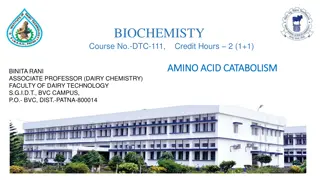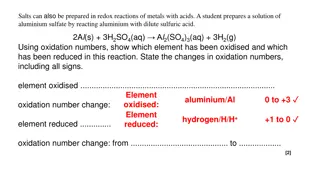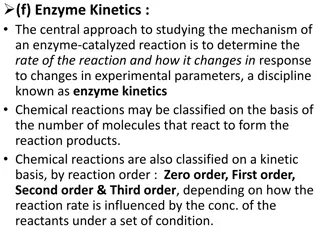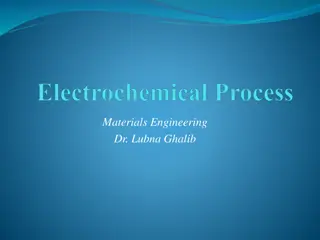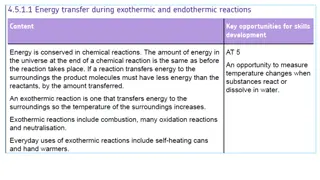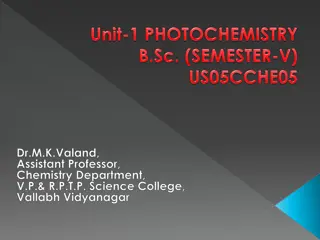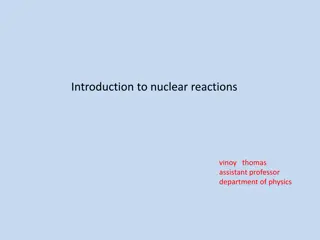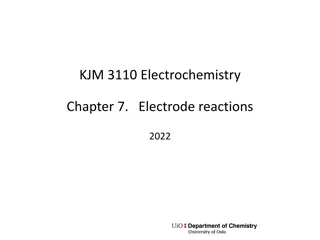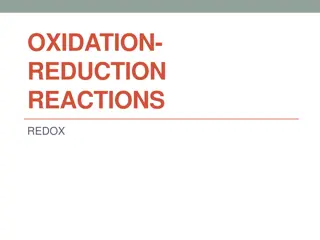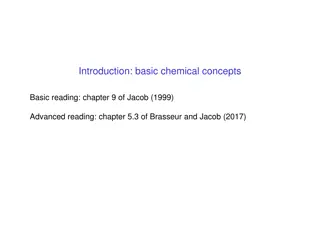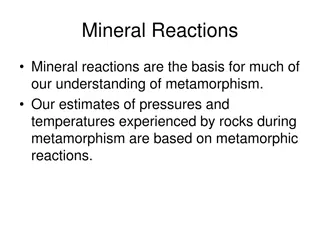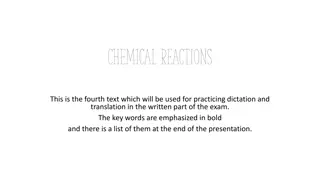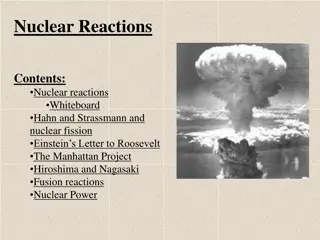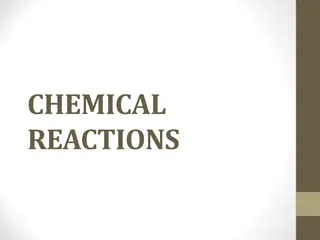Types of groups and reactions
This information discusses electron-donating groups (EDGs) and electron-withdrawing groups (EWGs), their effects on molecule reactivity, examples of each group, nucleophiles, and electrophiles. EDGs increase electron density, making nucleophiles stronger, while EWGs decrease electron density, making electrophiles stronger. Nucleophiles donate electrons to form covalent bonds, while electrophiles accept electrons. Understanding these groups and reactions is essential in organic chemistry.
Download Presentation

Please find below an Image/Link to download the presentation.
The content on the website is provided AS IS for your information and personal use only. It may not be sold, licensed, or shared on other websites without obtaining consent from the author.If you encounter any issues during the download, it is possible that the publisher has removed the file from their server.
You are allowed to download the files provided on this website for personal or commercial use, subject to the condition that they are used lawfully. All files are the property of their respective owners.
The content on the website is provided AS IS for your information and personal use only. It may not be sold, licensed, or shared on other websites without obtaining consent from the author.
E N D
Presentation Transcript
Types of groups and reactions By MSC. Hussien Ali Karim
Electron donating group An electron donating group (EDG) has the net effect of increasing electron density in a molecule through the carbon atom it is bonded to. By increasing electron density on adjacent carbon atoms, EDGs change the reactivity of a molecule: EDGs make nucleophiles stronger. With EDGs attached, a nucleophilic center is even more electron rich and ready to attack electrophilic sites. EDGs make carbon centers weaker electrophiles and less reactive to nucleophiles, because any (partial) positive charge it has will be minimized or nullified if the EDG is strong enough. Examples of good electron donating groups are groups with lone pairs to donate, such as: The oxygen anion, -O- Alcohol groups, -OH Amine groups, -NH2 or -NR2 Ethers, -OR Alkyl groups are also weakly electron-donating.
Electron withdrawing group An electron withdrawing group (EWG) is a group that reduces electron density in a molecule through the carbon atom it is bonded to. By reducing electron density on adjacent carbon atoms, EWGs change the reactivity of a molecule: EWGs make electrophiles stronger, because the electron-withdrawing effect makes any carbon center even more electron deficient than before. EWGs make any nucleophilic species less reactive, for the same reason as they strengthen electrophiles. Nucleophiles need electron density to react with electrophiles; if an EWG is withdrawing electrons, this is taking away the source of the nucleophile s strength! The strongest EWGs are groups with pi bonds to electronegative atoms: Nitro groups (-NO2) Aldehydes (-CHO) Ketones (-C=OR) Cyano groups (-CN) Carboxylic acid (-COOH) Esters (-COOR) Halogens are also electron-withdrawing; the effect gets weaker going down the group.
nucleophile Nucleophilic functional groups are those which have electron-rich atoms able to donate a pair of electrons to form a new covalent bond. In both laboratory and biological organic chemistry, the most relevant nucleophilic atoms are oxygen, nitrogen, and sulfur, and the most common nucleophilic functional groups are water, alcohols, phenols, amines, thiols, and occasionally carboxylates. They are electron-rich and hence nucleus loving. They are negatively charged or neutral. They donate electrons. They undergo nucleophilic addition and nucleophilic substitution reactions. A nucleophile is also called a Lewis base.
Electrophile the electrophilic atom is a carbon which is bonded to an electronegative atom, usually oxygen, nitrogen, sulfur, or a halogen. The concept of electrophilicity is relatively simple: an electron-poor atom is an attractive target for something that is electron-rich, i.e. a nucleophile. Positively charged or neutral species are called electrophiles that are deficient in electrons and can accept a pair of electrons. These are also called species that love electrons (philic). They are electron deficient and hence love to accept electrons (electrons loving). They are positively charged or neutral. They undergo electrophilic addition and electrophilic substitution reactions. An electrophile is also called Lewis acid.
Addition reaction is a chemical reaction wherein two or more reactants come together to form a larger single product. But only chemical compounds containing multiple bond character can undergo an addition reaction as a double or triple bond is usually broken to form the required single bonds. An addition reaction is essentially a reverse of a decomposition reaction wherein a decomposition reaction is a reaction where one compound decomposes into one or more elements or compounds. Looking at an example of an addition reaction, hydrochlorination of propane (an alkene), for which the equation is CH3CH = CH2 + HCl CH3C+HCH3 + Cl CH3CHClCH3 The most important types of addition reactions are : Nucleophilic addition reaction. Electrophilic addition reaction.
Nucleophilic addition reaction A nucleophilic addition reaction is a chemical addition reaction in which a nucleophile forms a sigma bond with an electron-deficient species. These reactions are considered very important in organic chemistry since they enable the conversion of carbonyl groups into a variety of functional groups.
Electrophilic addition reaction An electrophilic addition reaction can be described as an addition reaction in which a reactant with multiple bonds as in a double or triple bond undergoes its bond broken and two new bonds are formed.
Elimination reaction Elimination reaction is a type of reaction that is mainly used to transform saturated compounds (organic compounds which contain single carbon-carbon bonds) to unsaturated compounds (compounds which feature double or triple carbon-carbon bonds). An elimination reaction is a type of chemical reaction where several atoms either in pairs or groups are removed from a molecule. The removal usually takes place due to the action of acids and bases or the action of metals.
Substitution reaction The substitution reaction is defined as a reaction in which the functional group of one chemical compound is substituted by another group or it is a reaction which involves the replacement of one atom or a molecule of a compound with another atom or molecule. These type of reactions are said to possess primary importance in the field of organic chemistry. For example, when CH3Cl is reacted with the hydroxyl ion (OH-), it will lead to the formation of the original molecule called methanol with that hydroxyl ion. The following reaction is as shown below- CH3Cl + (OH ) CH3OH( methanol) + Cl One more example would be the reaction of Ethanol with the hydrogen iodide which forms iodoethane along with water. The reaction is as shown- CH3CH2OH + HI CH3CH2I + H2O
Alkylation reaction Alkylation is the shifting of an alkyl group from one molecule to another. The alkyl group can be shifted in various forms like carbanion, cabene, free radical or carbocation, depending on the situation and reaction. Alkylation is a chemical process through which an alkyl group is attached to some organic substrate molecule by methods like addition and substitution. Alkylation occurs in the presence of strong mineral acid or lewis acid, such as metal oxides, by using electrophilic alkylating agents like olefin and alkyl halide. In the case of aromatic compounds, alkylation leads to the addition of some simple carbon chains to the benzene ring. There is a contrasting process to alkylation known as dealkylation, which involves the removal of the alkyl group from a compound.
Acylation reaction Acylation is a chemical process wherein an acyl group is added to a compound or molecule, to be more precise. The acyl group is provided by a compound which is called the acylating agent. In this reaction, acyl halides are mainly used as the acylating agents. This is because acyl halides form a strong electrophile when they are treated with some metal catalysts. The mechanism of the Acylation reaction is based on the electrophilic aromatic substitution. As stated above, in Organic Chemistry, acylation is the process or mechanism of adding an acyl group (RCO-) to a particular compound. The reaction basically involves substitution by a nucleophile (electron donor) at the electrophilic carbonyl group (C = O) of a carboxylic acid derivative.
Esterfication Esterification is the process of combining an organic acid (RCOOH) with an alcohol (ROH) to form an ester (RCOOR) and water; or a chemical reaction resulting in the formation of at least one ester product. Ester is obtained by an esterification reaction of an alcohol and a carboxylic acid.
Steric hindrance Steric effects are the effects seen in molecules that come from the fact that atoms occupy space. When atoms are put close to each other, this costs energy. The electrons near the atoms want to stay away from each other. This can change the way molecules want to react. It can also change the shape (or conformation) of the molecule. The amount of space that a group of atoms takes is called the "steric bulk". Steric effects are nonbonding interactions that influence the shape (conformation) and reactivity of ions and molecules. Steric hindrance is a consequence of steric effects. Steric hindrance is the slowing of chemical reactions due to steric bulk. It is usually manifested in intermolecular reactions, whereas discussion of steric effects often focus on intramolecular interactions. Steric hindrance is often exploited to control selectivity, such as slowing unwanted side-reactions.




